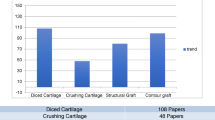Abstract
Background
Several rhinoplasty and nasal reconstruction procedures require cartilage. Various studies have reported on the nasal septal cartilage as a donor site for Caucasian and Asian populations. However, studies regarding the Thai nasal septal cartilage dimensions are rare. This study aimed to examine the length, height, area, and thickness of the nasal septal cartilage, along with implications of the size and quantity of the available cartilage, for grafting in Thai cadavers.
Methods
We analyzed the nasal septal cartilage in 42 Thai cadavers. The length, height, area, and thickness were digitally measured using ImageJ 1.52 software, along with the size and area of the available cartilage for grafting after preserving a 10-mm L-strut. Data were compared between sexes.
Results
The mean height, length, and area of the nasal septal cartilage were 30.96 ± 5.90 mm, 26.13 ± 6.90 mm, and 636.10 ± 196.13 mm2, respectively. The length did not differ significantly between sexes. However, the height and area in male cadavers were greater than those in female cadavers. The mean thickness ranged from 0.77 to 1.02 mm depending on the area, with the thickest and thinnest areas being the superoposterior and inferoposterior parts, respectively. The mean height, length, and area of the harvestable cartilage were 20.96 mm, 16.13 mm, and 384.84 mm2, respectively, after excluding the L-strut.
Conclusion
Our results provide major anatomical data of the Thai nasal septal cartilage. Its implication for use of the septal cartilage for grafting is 21 mm in height and 16 mm in length, which is sufficiently safe to maintain nasal support.
Level of Evidence IV
This journal requires that authors assign a level of evidence to each article. For a full description of these evidence-based Medicine ratings, please refer to the Table of Contents or the online Instructions to Authors www.springer.com/00266.




Similar content being viewed by others
References
Kim J, Cho JH, Kim SW, Kim BG, Lee DC, Kim SW (2010) Anatomical variation of the nasal septum: correlation among septal components. Clin Anat 23:945–949
Kim IS, Lee MY, Lee KI, Kim HY, Chung YJ (2008) Analysis of the development of the nasal septum according to age and gender using MRI. Clin Exp Otorhinolaryngol 1:29–34
Cervelli V, Bottini DJ, Gentile P, Fantozzi L, Arpino A, Cannatà C, Fiumara L, Casciani CU (2006) Reconstruction of the nasal dorsum with autologous rib cartilage. Ann Plast Surg 56:256–262
Sen C, Iscen D (2006) Caudal septal advancement for nasal tip projection and support in rhinoplasty. Aesthetic Plast Surg 30:135–140
Lee SH, Koo MG, Kang ET (2017) Septal cartilage/ethmoid bone composite graft: a new and improved method for the correction underdeveloped nasal septum in patients with short noses. Aesthetic Plast Surg 41:1–7
Han SE, Han K, Choi J, Yun TB (2016) Modified direct-type septal extension grafts: their stability and usefulness in Asian rhinoplasty. Ann Plas Surg 78:1
Choi JY, Kang IG, Javidnia H, Sykes JM (2014) Complication of septal extension graft in Asian patients. JAMA Facial Plast Surg 16:169–175
Godley FA (1997) Nasal septal anatomy and its importance in septal reconstruction. Ear Nose Throat J 76:498–506
Miles BA, Petrisor D, Kao H, Finn RA, Throckmorton GS (2007) Anatomical variation of the nasal septum: analysis of 57 cadaver specimens. Otolaryngol Head Neck Surg 136:362–368
Prabhu LV, Ranade AV, Rai R, Pai MM, Kumar A, Sinha P, Nayak SR (2009) The nasal septum: an osteometric study of 16 cadaver specimens. Ear Nose Throat J 88:1052–1056
Saunders MW, Jones NS, Kabala J (1995) An anatomical, histological and magnetic resonance imaging study of the nasal septum. Clin Otolaryngol 20:434–438
Samrid R, Chaisiwamongkol K, Thanaviratananich S, Sukhorum W, Yimdee J, Iamsaard S (2013) The anatomical study of the nasal septum in North-East Thai cadavers. Srinagarind Med J 28:279–281
Hwang K, Huan F, Kim DJ (2010) Mapping thickness of nasal septal cartilage. J Craniofac Surg 21:243–244
Hu K, Xu H, Lin Z, Chen Y (2019) Anatomical study of nasal septal cartilage in Eastern Chinese. J Surg 7:46–49
Author information
Authors and Affiliations
Corresponding author
Ethics declarations
Conflict of interest
The authors declare that they have no conflicts of interest to disclose
Ethical Approval
This cadaveric study was approved by our institution’s review board
Informed Consent
For this type of study, informed consent is not required
Human or Animal Rights
This article does not contain any studies with human participants or animals performed by any of the authors
Additional information
Publisher's Note
Springer Nature remains neutral with regard to jurisdictional claims in published maps and institutional affiliations.
Rights and permissions
About this article
Cite this article
Samibut, P., Meevassana, J., Suwajo, P. et al. The Anatomical Study of the Nasal Septal Cartilage with its Clinical Implications. Aesth Plast Surg 45, 1705–1711 (2021). https://doi.org/10.1007/s00266-020-02116-z
Received:
Accepted:
Published:
Issue Date:
DOI: https://doi.org/10.1007/s00266-020-02116-z




